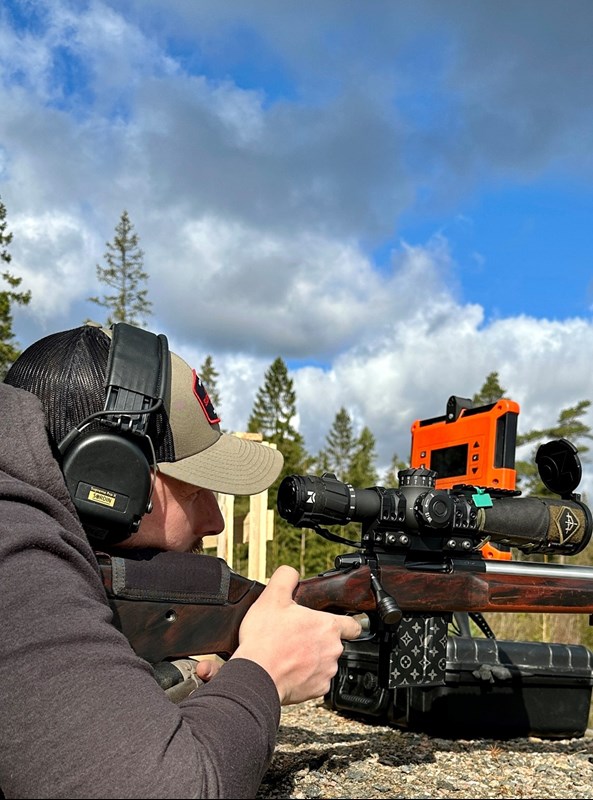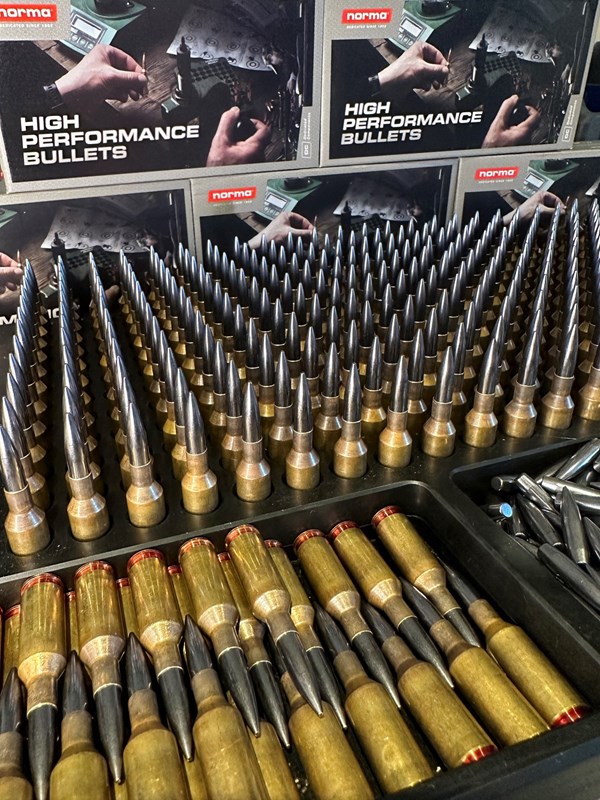Products (0)
Pages (0)
Reloading– How Does It Work and Is It Worth It?
Reloading– How Does It Work and Is It Worth It?
How do you reload and what do you need for reloading? The 2022 World Champion in Precision Rifle MIL/LEO and NORMA Ambassador, Louis Philippe Rembry, is a seasoned reloader. He shares some of his best reloading tips in this NORMA Academy article.
I often get asked about reloading. It’s quite a delicate subject, as every gun is unique and a specific loading formula for my gun may not work for yours. That’s why I never recommend that anyone copy someone else’s loading formula, but instead use the reloading data recommended by the manufacturers, (e.g. NORMA’s reloading database).
Two other aspects of reloading are cost and performance, which I will try to explain from my point of view. Then finally I will reveal how I develop a new loading formula.
Does reloading save money?
Do you actually save money by reloading? There are no simple answers to this; it all depends on how much you shoot and what you shoot. If you’re a normal hunter who maybe shoots 100 shots over the year at the moose track/target practice and maybe 10–20 shots of hunting ammo in a season, I would say no. If you hunt often and are active on the shooting range throughout the year, you can start to think about what level you are at.
A pack with everything you need to start reloading from one of the larger and well-established brands is currently around 600-700USD (as usual, don’t purchase the cheapest option). The tools for the various calibers you will need must usually be added to this. Depending on brand and quality, these cost from around 90USD upwards. Before we have even loaded our first shell, we will have spent 700USD. Then we need gunpowder, primers, casings and bullets. If you have saved your previous casings, I would say it costs around half as much to load your own bullet versus buying it in a shop.
So, do you save money by reloading? Each individual simply needs to be honest with himself and figure out how much he is going to shoot, and then decide whether he wants to invest the time it takes to develop one or more loads to optimize the weapon's conditions.

Why do we reload? Optimize your weapon’s conditions
So, why do we reload? It’s all about optimizing the conditions for your particular weapon. As I mentioned previously, every gun is unique, and it can sometimes be difficult to find ammunition that fits your particular weapon or that meets all your requirements as a hunter or sport shooter. Personally, I hunt with factory loaded loaded ammunition, as I think it performs well enough for my weapons, so it’s not worth reloading. On the other hand, I reload all the ammunition for my sporting gun, as I expect my gun to be able to perform with optimal conditions for that particular barrel.
Why is reloaded ammunition better when compared to factory loaded ammunition? Experience, knowledge and conditions naturally come into play here, but for modern guns, a good reloading kit and tools normally enable me to cut the dispersion of traditional hunting weapons in half.
To reduce the dispersion from 3 cm to 1.5 cm at 100 meters doesn’t play a major role in driven hunts, but if you’re going to hunt from greater distances, you want to be able to ensure a high precision so as not to injure the animal unnecessarily when shooting.
How to develop a new loading formula
Grain = weight of bullets and gunpowder
M/S = velocity, meters per second
ES = Extreme spread, greatest difference in velocity between highest and lowest
SD = Standard deviation, average difference in velocity on the shot series
Seating depth = how far into the cartridge the bullet is
Jump = How close the bullet is to the barrel
Calibration = Reset of the casing’s desired measurement
Chronograph = Used to measure the velocity of the bullet
The first step in developing a new loading formula is to determine what velocity I want it to reach. As a sport shooter, I find this to be about recoil versus performance, and as a hunter I find that the velocity determines what impact energy I need to meet the requirements for the specific with which caliber I will hunt. Once I’ve determined what range I want to reach, I look in the manufacturer’s database for the minimum and maximum loadings, so that my expectations with regard to velocity are reasonable for the properties of the caliber.
If I have completely new casings, I will not do any preparatory work, but if I use a casing that has been shot, I make sure I measure the casing neck using a headspace gauge which you put on your caliper. This is an easy way to know how much you need to calibrate the casing neck. You start by measuring the shot gauge and then adjusting the tool so that it calibrates the casing neck back around 0.05 mm (you can set it both higher and lower, but 0.05 mm works well for me) and test so that the casing can be closed in the receiver with the bolt without any hindrance or resistance. If you do not have a caliper and headspace kit, you can set up the tool to the maximum setting and then slowly adjust down until the casing can be inserted into the receiver without obstruction.
The next step is cleaning, and here I keep things relatively simple. I clean the primer pocket with the tool you get in the kit. I then throw it into the ultrasonic cleaner together with some washing-up liquid and finally place it in the drying cabinet overnight.
Then it’s time to insert a primer and this must be placed deep enough so that the casing can stand upright on the table without wobbling due to the primer protruding. I then normally load a 5–10 shot loading gate(depending on how much knowledge I have about this calibre and loading), where I slowly increase the quantity for each cartridge for example one shot per 0.2 grain increase between 30 and 32 grains of gunpowder. The bullet’s seating depth is not something I focus on; I use a standard measurement here.
It is now time to shoot the loading gate and I do this using a chronograph. I put up various guidelines for all shots and shoot from the lowest to the highest loading and look at the underside of each shell for signs of wear (primer starting to “mushroom” or marks on the casing from the extractor) while noting the velocity of each shot.
Afterwards, I analyze the dispersion and velocities. What I’m looking for is a plateau in velocity and for the dispersion to be the same. For example: 30.4 grain low at 830/ms, 30.6 grain low at 833/ms and 30.8 grain low at 836/ms. In this case, I think it would be interesting to look more closely at 30.6 grains, as the velocity both above and below look stable and the dispersion of all three is identical, which makes the loading not as sensitive if there is too much or too little gunpowder.

It is now time to go home and load up three of each around 30.6 grains to see how even they are over a series of shots, rather than on a single occasion. I therefore load three of 30.5, 30.6 and 30.7 and go back to the shooting range to check how even each loading is using my chronograph. I only do three for the simple reason that if it doesn’t shoot evenly with three there is no point in shooting more. What you are looking for is, of course, the loading that shoots best and is most even in velocity, but now we are only focusing on velocity. After shooting three of each loading, I find one that stands out and gives me low ES and SD, which in simple terms are maximum deviation and average deviation.
We are now nearly ready, but first we have to determine which seating depth we will use. The seating depth is the fine adjustment which helps us to shrink dispersion. Here, I look at two factors. The first is that it must function error-free with the magazines I use, and the other is that I want the jump to be forgiving, so that you are not so close to the rifling that it could be a problem if you get dirt or something similar in the gun. There is a tool for this that measures from the bullet’s ogival instead of the tip of the bullet, as this can differ between bullets depending on type. I use exactly the same method here; I make three of each type that I decide on and then take the one that shoots best in the middle so it won’t be so sensitive to the wear that will arise in the chamber.

I have now found the right loading, bullet and seating depth, it is time to load up five-ten shots and double check that the loading is consistent over a greater range. You can’t always see deviations in smaller series.
Reloading is not difficult, but it does require some time in the beginning, until you have found the right loadings. Then it’s just a matter of copying them. I recommend all new beginners to either take a reloading class, or to load their first shot together with a friend who has experience doing it, to ensure that you do it correctly.
So, is reloading worth it compared to buying factory loaded ammunition? In short, it entirely depends on what you want to get out of your weapon, how much time and money you are prepared to spend and how much you shoot in a year.
